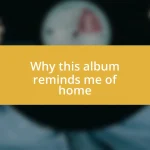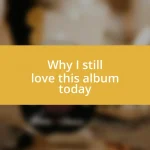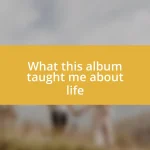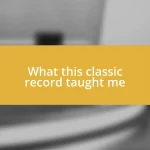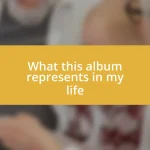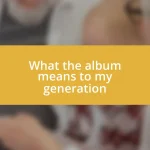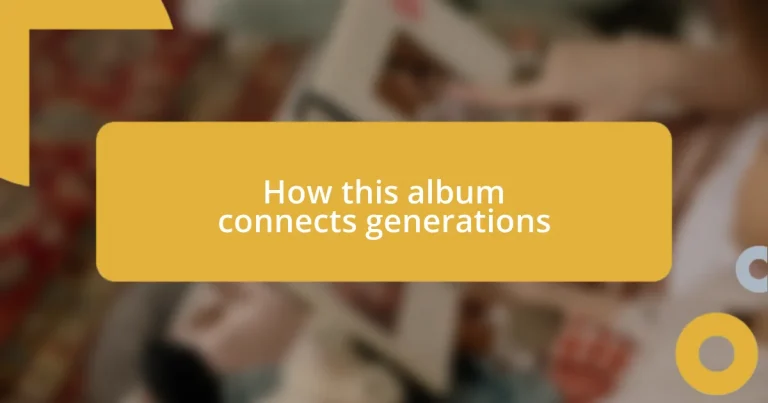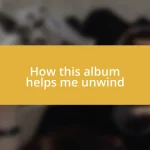Key takeaways:
- Generational connections through music foster understanding and empathy, transcending age differences and creating shared emotional experiences.
- Albums like those by The Beatles, Nirvana, and Queen serve as cultural bridges, linking past and present while resonating with universal themes of love and struggle.
- Engaging in activities like musical memory jars and collaborative playlists promotes intergenerational dialogue and deepens relationships through shared narratives and stories behind songs.

Understanding generational connections
Generational connections often spark when we find common ground in music, art, and shared experiences. I remember my own father played vinyl records when I was a child. The scratchy sound of classic rock not only bonded us over a shared love for those tunes but also opened my eyes to the stories and emotions tied to that era. Isn’t it fascinating how a simple song can transport us to another time, allowing us to see the world through the eyes of generations past?
These connections are more than just nostalgic moments; they serve as bridges across age gaps. I often find myself discussing current artists with my younger cousin, who listens to music I initially thought was just for my generation. The way we both interpret lyrics reveals how themes of love, struggle, and hope resonate through time. It’s a reminder that emotions transcend age—don’t you think it’s incredible how something so intangible can connect us?
When you dive deeper, you realize that generational connections are about understanding and empathy. For instance, I once attended a music festival that showcased bands from various decades, and witnessing people of all ages singing along was astonishing. It was as if each note told a story that everyone could feel, a genuine reminder that while times change, our feelings and connections can remain strikingly similar. How do you think your choices in music or art reflect this continuity between generations?

Album history and its impact
The history of an album often encapsulates significant cultural shifts and movements, bridging divides between different generations. I recall discovering an old Beatles album in my grandmother’s attic, its cover worn yet vibrant. Listening to those melodies transported me to a time when young people were actively shaping societal change. It struck me how those same songs could spark a discussion with my friends today, highlighting that the magic of music lies not only in the notes but in the stories it tells.
As albums evolve, so does their influence on successive generations. When I think about how impactful icons like Nirvana became, I can’t help but feel a connection with younger listeners who are discovering their music for the first time. This moment of cross-generational discovery gives me hope that the emotions conveyed in these songs—struggles with identity, mental health, and love—resonate universally. It’s almost like a rite of passage where younger fans get to feel the rawness of a past era while creating their own memories with those sounds.
The lifecycle of an album often reflects not just musical progression but a communal experience that transcends time. I once witnessed my friends belt out a classic Queen anthem at karaoke night, completely unaware of how it echoed the struggles of both past and present. Their energy was contagious, reminding me that legendary tracks become anthems that continue to inspire even as generations shift. It’s fascinating how such a song can forge connections, allowing everyone, regardless of their era, to stand united under its powerful beat.
| Album | Impact on Generations |
|---|---|
| The Beatles | Inspired cultural movements and fostered discussions across decades. |
| Nirvana | Resonated with youth in subsequent generations, addressing universal struggles. |
| Queen | Created anthems that unite listeners from different eras during shared experiences. |

Shared experiences through music
Music acts as a soundtrack to our lives, creating shared experiences that linger in our memories. I remember the first time I attended a concert with my siblings—we sang along to our favorite band, feeling an electric connection that was almost tangible. That night, the music wasn’t just playing; it was bringing our different ages and perspectives together, making us feel like one collective heartbeat. Each song was a reminder that no matter how far apart we might seem in years, we were all united in that moment.
- Live performances blur age gaps, as people from different generations sing together, sharing a single emotional space.
- Participating in music-themed events, like karaoke night, can spark conversations that reveal surprising similarities across generations.
- I’ve seen how a nostalgic playlist can ignite a sense of camaraderie, leading to storytelling sessions about the memories each song evokes.
When I think about road trips with friends, the playlist becomes a character of its own—highlighting our shared experiences in a lively way. One trip, we blasted 90s hits that I grew up with, each track igniting laughter and stories that only a shared love for music could trigger. Seeing my friends bond over these tunes, even though they weren’t part of my generation, reminded me that music holds a unique power: it transcends time and creates a shared narrative we can all be part of.
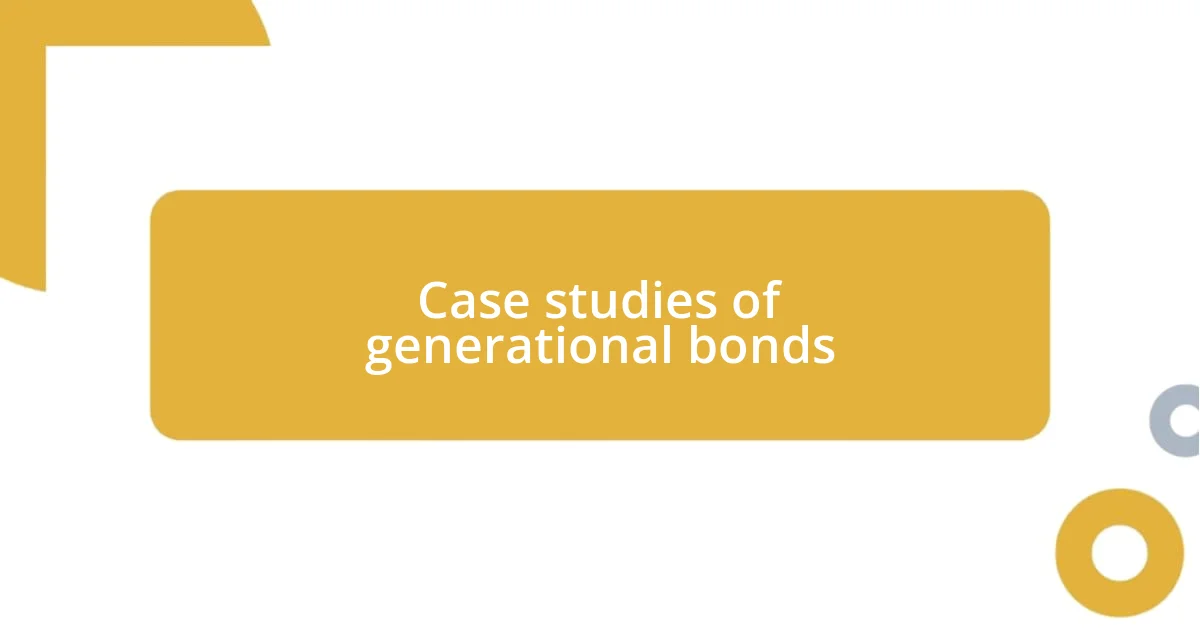
Case studies of generational bonds
When I think of my family gatherings, I often notice a unique phenomenon: the shared laughter that erupts when my parents and I reminisce about the first time we heard a particular song. I remember vividly how my dad lit up talking about his college days dancing to the Rolling Stones, while I chimed in with stories of singing along to those same songs at summer festivals. It made me wonder how many others experience that same delightful juxtaposition, where music becomes a bridge between their past and our present.
A few years back, I volunteered at a community center where we organized music appreciation nights. The joy was palpable as young kids, armed with shiny new headphones, discovered the disco beats of the 70s. I found it incredible how their eyes widened with excitement, and they started to incorporate those funky rhythms into their own dance moves. It got me thinking: what is it about music that allows us to break down the barriers of age? That night felt like an epiphany, highlighting just how influential an iconic track can be in connecting generations through rhythm and joy.
Reflecting on conversations with my grandparents about their favorite musicians brings me a sense of nostalgia mixed with warmth. I recall sitting on their porch one summer evening, as they recounted tales of record shops and album launches from decades ago. Their eyes sparkled with passion as they shared how music provided solace during tough times. I couldn’t help but ponder how these stories, steeped in love for the artists of their youth, weave a rich tapestry that binds us together, revealing our shared humanity across the years.

How to promote intergenerational dialogue
Promoting intergenerational dialogue can be as simple as sparking conversations around music. For instance, I recently hosted a small family gathering where we created a “musical memory jar.” Each person wrote down a song that held special meaning for them and shared why it resonated with their life. It was incredible to hear my teenage niece relate to my joy over a specific classic rock tune, discovering that the dreams we chase often have the same soundtrack—no matter the generation. This exercise made me realize how the stories behind our favorite songs connect us in unexpected ways.
Another effective approach is to create collaborative playlists that feature tracks from various eras. Last summer, I joined a community group that encouraged members of different ages to contribute songs to a shared Spotify playlist. When we gathered to listen, it was enlightening to see how each generation interpreted the music differently. I laughed as my friends attempted to dance to the funky grooves my parents loved, while my dad shared the stories behind those tracks. It dawned on me just how music can be a conversation starter, revealing layers of history and emotion that words alone might not convey.
I recall a moment from a holiday dinner last year where my grandmother played a song from her youth on the piano. The room filled with memories as she shared stories about dancing with my grandfather during their courtship. It made me reflect: how often do we take the time to pause and listen to these narratives? Each melody invites us to learn not only about the song itself but also about the lives intertwined with it. Encouraging such moments fosters understanding, reminding us that music binds us together, creating a bridge to meaningful conversations across generations.
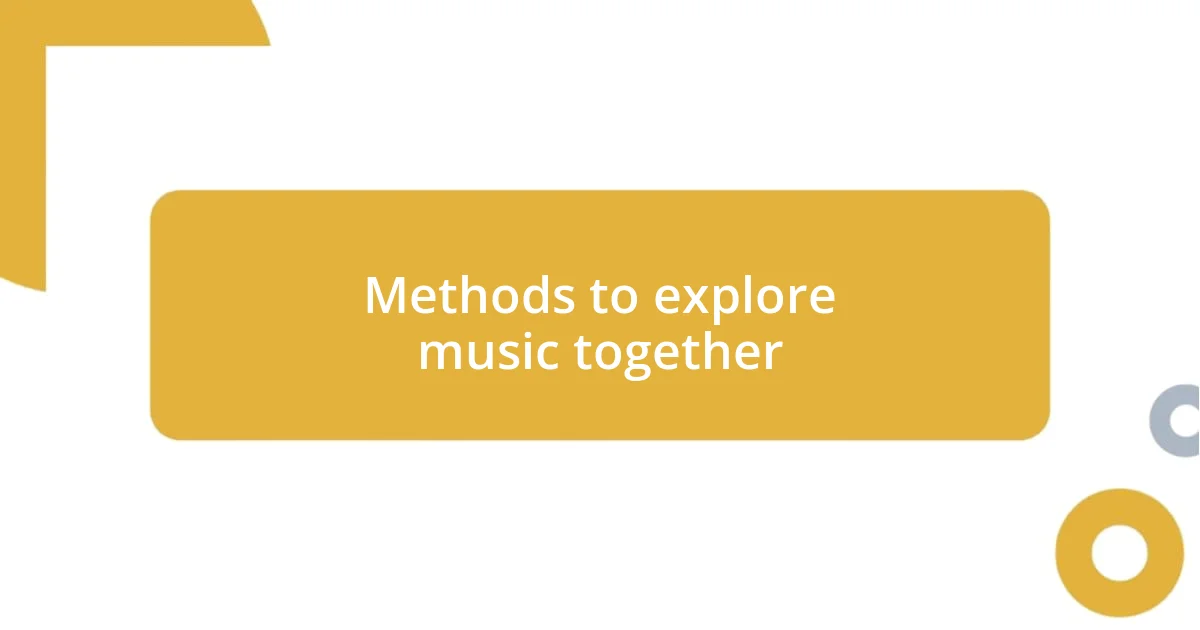
Methods to explore music together
Exploring music together opens up a world of engagement. I recently led a music workshop at our local library that featured songs from different eras, where participants were invited to bring a track that defined their youth. Watching a grandmother blush as she revealed her favorite Elvis song while her granddaughter squealed in delight at the thought of listening to it on repeat reminded me how sharing music can ignite cherished memories and foster deeper relationships across generations.
Another method I love is organizing listening parties. A few months back, I invited friends and family over for a movie night centered around music documentaries. We all settled down with popcorn, and I was surprised at how deeply everyone connected with the stories of musicians from the past. As we laughed and debated the best performances, I wondered: isn’t it fascinating how these artists, through their struggles and triumphs, shape our understanding of life? It became evident that music transcends time, sparking intense discussions about our personal connections to these tunes.
Sometimes, I think there’s nothing quite like the power of a shared concert experience. I took my nephew to see a band his parents adored when they were young. Watching him sway to the music, a mix of confusion and glee on his face, made me consider how live performances create a sense of belonging. It was a moment where generations converged under the same rhythm, united in a feeling that words, alone, could never capture. Could there be a more vivid illustration of music’s role as a connector?

